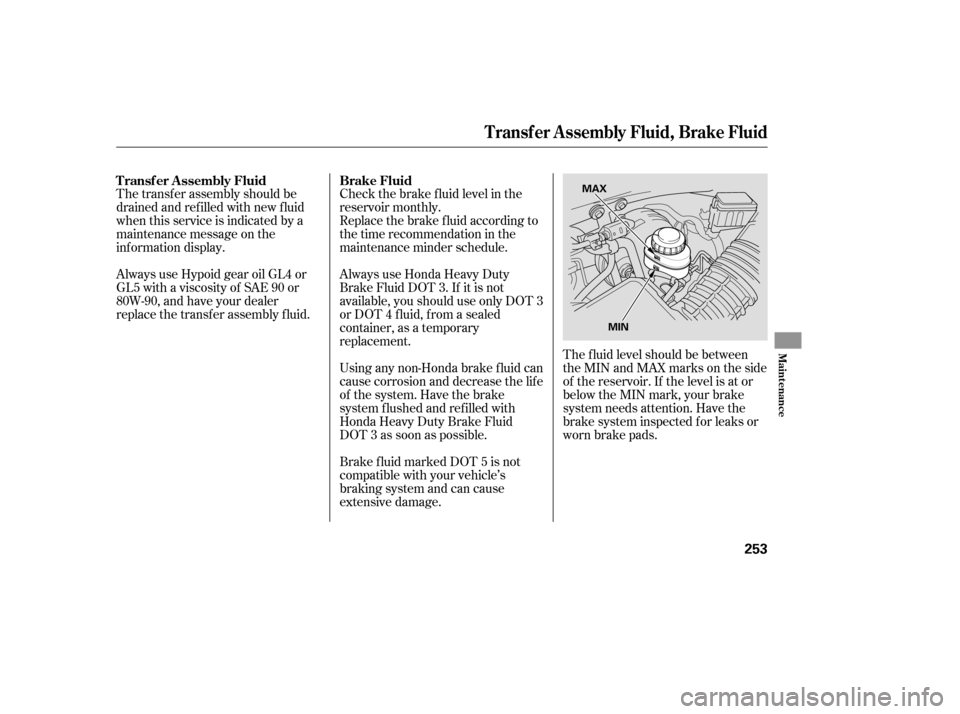Page 257 of 331

The transf er assembly should be
drained and ref illed with new f luid
when this service is indicated by a
maintenance message on the
inf ormation display.
Always use Hypoid gear oil GL4 or
GL5 with a viscosity of SAE 90 or
80W-90, and have your dealer
replace the transfer assembly fluid.Check the brake f luid level in the
reservoir monthly.
Replace the brake f luid according to
the time recommendation in the
maintenance minder schedule.
Brake f luid marked DOT 5 is not
compatible with your vehicle’s
braking system and can cause
extensive damage. Using any non-Honda brake f luid can
cause corrosion and decrease the lif e
of the system. Have the brake
system f lushed and ref illed with
Honda Heavy Duty Brake Fluid
DOT 3 as soon as possible. Always use Honda Heavy Duty
Brake Fluid DOT 3. If it is not
available, you should use only DOT 3
or DOT 4 f luid, f rom a sealed
container, as a temporary
replacement.
The f luid level should be between
theMINandMAXmarksontheside
of the reservoir. If the level is at or
below the MIN mark, your brake
system needs attention. Have the
brake system inspected f or leaks or
worn brake pads.
Brake Fluid
Transf er Assembly Fluid
Transf er A ssembly Fluid, Brake Fluid
Maint enance
253
MAX
MIN
Page 266 of 331

A non-Honda floor mat may not fit
your vehicle properly. This could
prevent the proper operation of the
folding rear seats and the passenger’s
seat weight sensors. We recommend
using genuine Honda floor mats. Do
not put additional floor mats on top
of the anchored mats. This
filter removes the dust and
pollenthatisbroughtinfromthe
outside through the heating and
cooling system/climate control
system.
Have your dealer replace this filter
when this service is indicated by a
maintenance message on the
info rmation display. It should be
replaced every 15,000 miles (24,000
km) if you drive primarily in urban
areas that have high concentrations
of soot in the air, or if the air flow
from the heating and cooling
system/climate control system
becomeslessthanusual. Check
the condition of the wiper
blades at least every six months.
Replace them if you find signs of
cracking in the rubber, areas that are
getting hard, or if they leave streaks
and unwiped areas when used.
To replace a wiper blade: To raise the wiper arm, turn the
ignition switch to the ON (II)
position and activate the wipers
(see page ). When the wipers
are in the upright position, turn
the ignition switch off to stop the
wipers in that position.
1.
75
Dust and Pollen Filter
Wiper Blades
Floor Mats, Dust and Pollen Filter, Wiper Blades
262
Page 284 of 331
Tighten the wheel nuts securely in
the same crisscross pattern. Have
the wheel nut torque checked at
the nearest automotive service
f acility.
Tighten the wheel nuts to:Place the flat tire face up on the
tire tray.
Remove the spacer cone f rom the
wing bolt, turn it over, and put it
back on the bolt.
Securetheflattirebyscrewing
the wing bolt back into its hole.Release the tire tray and slide it
back in place.
Tighten the tire tray holding bolts
securely.
Remove the center cap from the
flat tire.
18.
19.
20.
21.
22.23.
24.
On RTX, RTS, RTL, and Canadian
EXL models
Changing a Flat Tire
280
WING BOLT
SPACER CONE For normal
tireFor spare
tire
94 lbf·ft (127 N·m , 13 kgf·m)
Page 292 of 331

Safely pull off the road, and shut
off the engine. Turn on the hazard
warning indicators.
Let the vehicle sit for a minute.
Op en the hood, and check the oil
level (see page ). An engine
very low on oil can lose pressure
during cornering and other driving
maneuvers.
If necessary, add oil to bring the
level back to the full mark on the
dipsti ck (see page ). If
the charging system
indicator comes on brightly
wh en the engine is running, the
battery is not being charged.
Immediately turn off all electri cal
accessories. Try not to use other
electrically operated controls such as
the power windows. Keep the engine
running; starting the engine will
discharge the battery rapidly.
This
indicator should never
come on when the engine is
running. If it starts flashing or stays
on, the oil pressure has dropped very
low or lost pressure. Serious engine
damage is possible, and you should
take immediate action.
Start the engine, and watch the oil
pressure indicator. If it does not go
out within 10 seconds, turn off the
engine. There is a mechanical
problem that needs to be repaired
bef ore you can continue driving
(see on page
). Go to a service station or garage
where you can get technical
assistance.
1.
2.
3.
4.
182
246
296
L ow Oil Pressure Indicator
Charging System Indicator
Emergency T owing
L ow Oil Pressure Indicator, Charging System Indicator
288
Running the engine with low oil
pressure can cause serious mechanical
damage almost immediately. Turn of f
the engine as soon as you can saf ely get
the vehicle stopped.
Page 294 of 331

However, if the brake pedal does not
feel normal, you should take
immediate action. A problem in one
part of the system’s dual circuit
design will still give you braking at
two wheels. You will feel the brake
pedal go down much farther before
the vehicle begins to slow down, and
you will have to press harder on the
pedal.
Slow down by shifting to a lower
gear, and pull to the side of the road
when it is safe. Because of the long
distance needed to stop, it is
hazardous to drive the vehicle. You
should have it towed, and repaired as
soon as possible. (See
on page .)
If you must drive the vehicle a short
distance in this condition, drive
slowly and carefully.
The
brake system
indicator normally
comes on when
you turn the ignition switch to the
ON (II) position, and as a reminder
to check the parking brake. It will
stay on if you do not fully release the
parking brake.
If the brake system indicator comes
on while driving, the brake fluid level
is probably low. Press lightly on the
brake pedal to see if it feels normal.
If it does, check the brake fluid level
thenexttimeyoustopataservice
station (see page ). If the ABS indicator and the VSA
system indicator come on with the
brake system indicator, have your
vehicle inspected by your dealer
immediately.
If the f luid level is low, take your
vehicle to a dealer, and have the
brake system inspected f or leaks or
worn brake pads. 253
296Emergency
Towing
Brake System Indicator
290
Canada
U.S.
Page 300 of 331

If , due to damage, your vehicle must
be towed with all f our wheels on the
ground, do the f ollowing:Release the parking brake.
Start the engine.
Shif t to D f or several seconds,
then to N.
Turn of f the engine. With all f our wheels on the ground,
it is best to tow the vehicle no farther
than 50 miles (80 km), and keep the
speedbelow35mph(55km/h).
If your vehicle needs to be towed,
call a prof essional towing service or
organization. Never tow your vehicle
with just a rope or chain. It is very
dangerous.
The operator will load
your vehicle on the back of a truck.
Any other method of towing will
damage the drive system. When you
contact the towing agency, inf orm
them a f lat-bed is required.
Emergency Towing
The only way you can saf ely tow
your vehicle is with f lat-bed
equipment.
296
Improper towing preparation will
damage the transmission. Follow the
above procedure exactly. If you cannot
shif t the transmission or start the
engine, your vehicle must be
transported with the all f our wheels of f
the ground. The steering system can be damaged if
the steering wheel is locked. Leave the
ignition switch in the ACCESSORY (I)
position, and make sure the steering
wheel turns f reely bef ore you begin
towing.
Towing your vehicle with two tires on
the ground will damage parts of the
4WD system. It should be transported
on a f lat-bed truck or trailer. Trying to lif t or tow your vehicle by the
bumpers will cause serious damage.
The bumpers are not designed to
support the vehicle’s weight.
Page 301 of 331
If your vehicle gets stuck in sand,
mud, or snow, call a towing service
to pull it out (see the previous page).
For very short distances, such as
f reeing the vehicle, you can use the
tie down hooks on the lower lef t of
the f ront and rear bumpers.
CONT INUED
If Your Vehicle Gets Stuck
T aking Care of t he Unexpect ed
297
FRONTREAR
TIE DOWN
HOOK TIE DOWN
HOOK
‘‘Rocking’’ your vehicle between
f orward and reverse gear or revving up
the engine and allowing the wheels to
spin f reely at high speeds can damage
the automatic transmission. Use a tow
service to prevent transmission damage.
Page 308 of 331

�µ
The tires on your vehicle meet all
U.S. Federal Saf ety Requirements.
All tires are also graded f or
treadwear, traction, and temperature
perf ormance according to
Department of Transportation
(DOT) standards. The f ollowing
explains these gradings.
Quality grades can be f ound where
applicable on the tire sidewall
between the tread shoulder and the
maximum section width. For
example: The treadwear grade is a compara-
tive rating based on the wear rate of
the tire when tested under controlled
conditions on a specif ied government
test course. For example, a tire
graded 150 would wear one and one-
half (1 1/2) times as well on the
government course as a tire graded
100. The relative perf ormance of
tires depends upon the actual condi-
tions of their use, however, and may
depart signif icantly f rom the norm
due to variations in driving habits,
service practices, and dif f erences in
road characteristics and climate.The traction grades, f rom highest to
lowest, are AA, A, B, and C. Those
grades represent the tire’s ability to
stop on wet pavement as measured
under controlled conditions on
specif ied government test surf aces
of asphalt and concrete. A tire
marked C may have poor traction
perf ormance.
Warning: The traction grade
assignedtothistireisbasedon
straight-ahead braking traction tests,
and does not include acceleration,
cornering, hydroplaning, or peak
traction characteristics.
All passenger car tires must conf orm
to Federal Saf ety Requirements in
addition to these grades. Unif orm T ire Quality Grading
T readwear 200
Traction AA
Temperature A Treadwear Traction AA, A, B, C
DOT Tire Quality Grading (U.S. Vehicles)
304